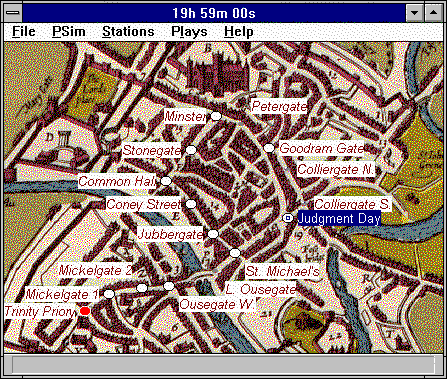

The default simulation, like the tabular calculations of Margaret Dorrell Rogerson's 1974 study, concludes at 19 hours and 59 minutes. Her study, like those advocating competing production theories, estimated the performance length of each individual play by counting the number of lines in each play. Line counts generally do not account for lengthy pieces of stage business, processional entrances and exits, music, and song, and are therefore risky. For simplicity's sake, Rogerson's calculations assumed that wagons did not need any set-up or break-down time. PSim makes the same assumption, and provides a relatively painless way to modify other factors in the calculation (such as the number of plays or stations participating in the cycle).
In 1977, the Records of Early English Drama and the Poculi Ludique Societas reconstructed all 48 Register plays in Toronto, Canada. Videotapes of the entire production provided an excellent opportunity to time each individual production with a stopwatch. These observed times do include pauses for stage business, music, entrances and exits, and so forth. The observed performance times include intentional pauses for stage business and also unintentional pauses for actors who forget their lines, props that do not cooperate, and in the case of The Nativity, a stray dog whose extemporaneous investigation of the manger set earned a show-stopping ovation from the audience. When PSim uses these observed performance lengths instead of line-count estimages, the default simulation produces a simulated overall performance length [19 hours, 31 minutes] is actually slightly shorter than the line-count estimate.